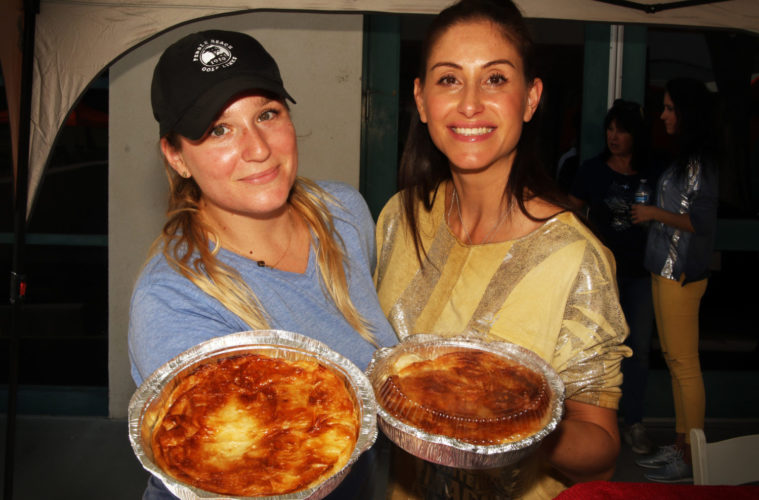It has frequently been said that variety is the spice of life. Because of this and the occasionally forgotten Emma Lazarus sonnet adorning the Statue of Liberty — which in part reads “Give me your tired, your poor, Your huddled masses yearning to breathe free” — the more enlightened portions of the United States have always embraced the concept of a melting pot. The city of Irvine is a prime example. No, this is not a reference to the recently closed fondue restaurant The Melting Pot of Irvine; rather, it is a testament to the cultural diversity that can be found here. On November 2, members of the Nativity of the Most Holy Theotokos Serbian Orthodox Church and their extended family and friends hosted the 6th Annual Taste of Europe Food and Folk Festival at Woodbridge Community Park.
While the organizers of the event are principally tied to Serbian culture, the Taste of Europe highlighted cultural traditions, including music, dancing, children’s activities and especially foods from a variety of European countries. Irvine Weekly visited the festival to sample some delicious food, enjoy a bit of music, and speak with organizer Natasha Stojanovic about the festival’s history and diversity. “We are a Serbian community, open to every other [community of] European diversity to bring together a bigger community,” Stojanovic explained. “We are celebrating European diversity, encouraging people to watch and learn traditional dances from different European countries and to cherish and teach them to younger generations.”

(Scott Feinblatt)
Stojanovic elaborated on the varieties of cultural dancing traditions that are showcased at the festival. “Today we have dancers from Serbia; we have dancers from Bulgaria; we have dancers from Macedonia — dancers from all different countries.” As the MC for the event, Stojanovic introduced the various musicians and dancing demonstrations throughout the day. For each of her introductions, she’d written a poem to highlight the respective attributes of the performers. For example, her poem introducing the Serbian dancers identified the style of the group. “In English, it’s called a dance / but there is a special word you won’t forget, no chance / In Serbian, it’s called kolo / you dance in a group, not solo.”
At a glance, the festival was very small. When the Weekly visited, the outdoor area of the community center hosted a handful of vendors, about half a dozen varieties of traditional European food and drink stands, a performance area, a children’s area, and a dozen or so dining tables. Stojanovic explained that the size of this year’s event represented neither the large number of the community’s traditional performers nor a limitation of the passion that the community has for sharing its diversity. “Two years ago, I had 147 performers. We were really going [all] out, and then I realized that it’s not really feasible to do it. I mean, I’m not Irvine [Global Village] Festival, you know … [but we have] very passionate people. The whole community comes together. We cook traditional European foods from scratch and … these people and kids dance every week and put their heart and soul into this.”
While the festival does not have a religious overtone, the community is essentially that of a church outreach event. This church, however, is particularly diverse, and it is this diversity that fuels the event’s multiple flavors. “We do have a Serbian church. It’s very multicultural; we have Bulgarian people, Russian people, Macedonian people, Serbian people, ex-Yugoslavian people … everyone comes together and … once a year we celebrate our traditions, our culture, and just kind of show [the greater local community] what we are coming from.” Stojanovic pointed out that Irvine has been a great place to experience cultural diversity. “I’ve lived here for 23 years in Irvine, and I love when I watch other cultures and learn, because there’s so much to learn. Then I also very much enjoy when someone comes and watches us. We’re just sharing.”

Pečenja (Scott Feinblatt)
Among the various food stands, there were home-cooked meals representative of the cuisines of four countries. From Serbia there were pečenja i sarma (rotisserie pork or lamb and stuffed cabbage rolls) and Ćevapi sa kajmakom i lukom (minced meat with clotted cream and onions) [which we tried…and loved]; from Italy there was spaghetti with meatballs (featuring homemade marinara sauce and garlic bread); from Greece there were Mediterranean rotisserie chicken and gyros dishes; from Germany there was sausage with sauerkraut (served with scallion potatoes). A final food stand served a dish that is popular in a number of countries from the Balkans and beyond: burek. Burek sa mesom (filo pie with beef) and burek sa sirom (filo pie with feta cheese) both looked delicious, but given only one stomach (which we’d already filled), we opted to save the bureks for next time. Each of the plates was $15, which was reasonable given the delicious and exotic qualities of the selections.

(Scott Feinblatt)
There was also a dessert stand, which offered a tempting variety of sweets. Those included: vanilice (nutty walnut and vanilla cookies with jam), baklava, tiramisu, apple strudel and crepes. For beverages, there were several standard coffee-based drinks available as well as water, soda, and a few alcoholic choices (featuring imported Serbian beer). All of the proceeds from the food sales went to the church and community.
“We’re trying to bring everyone and say, ‘Hey, let’s be a family here,’” said Stojanovic as she emphasized her desire to bridge cultural gaps and her wish that such diversity would not only be reserved for special occasions. “I have friends from Australia, from Peru, from like everywhere in the world, and I cherish that. They opened my eyes to different things and I want to see what can I do better in my life [by] learning other stuff.”
Advertising disclosure: We may receive compensation for some of the links in our stories. Thank you for supporting Irvine Weekly and our advertisers.

